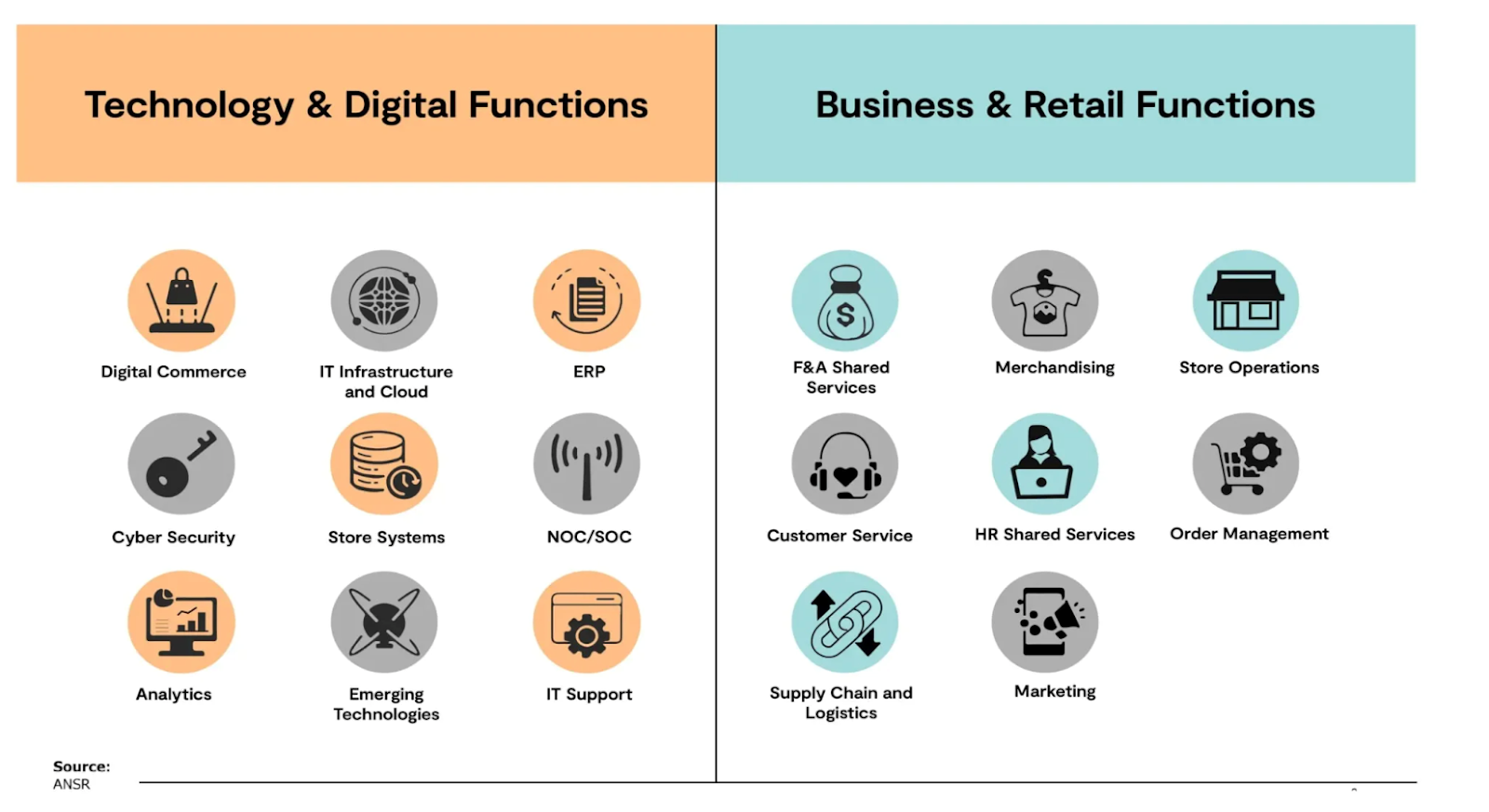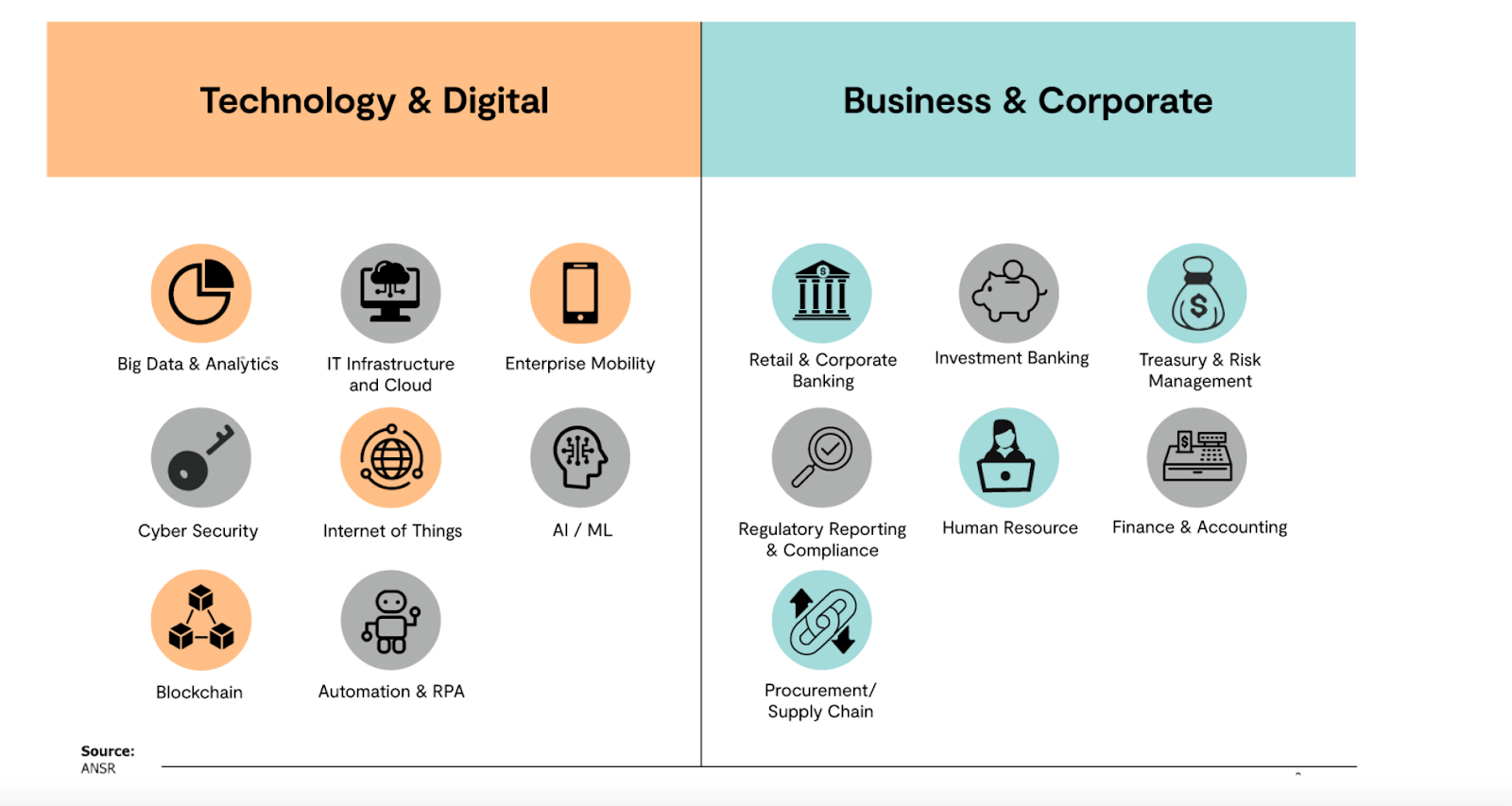Global Inhouse Center
With some of the most influential companies actively pursuing global expansion, Global In-house Centers have emerged as one of the most popular models of building and scaling global teams.
Global In-house Centers, also known as captive centers, shared service centers, global capability centers, global technology hubs, and global business centers, are fully owned and integrated centers established in talent-rich locations. Acting as an extension of the enterprise, Global In-house Centers deliver strategic functional and operational capabilities to their parent companies. They play a crucial role in:
- Accelerating digital transformation initiatives
- Developing new and advanced product features
- Driving innovation across the enterprise
- Optimizing operational processes
- Increasing cost efficiency and resource utilization
Global In-House Centers as Centers of Excellence
Delivering access to high-caliber talent and strategic, cross-functional capabilities, Global In-house Centers often serve as centers of technological excellence and innovation for the enterprise. Uniting top talent, advanced tools, technologies, and subject matter expertise to cultivate exceptional capabilities in specific business areas, GICs cultivate the ideal environment for concentrated capabilities for a specific objective. By centralizing specialized knowledge and resources, GICs enhance innovation and efficiency, driving competitive advantage.
Trusted by the Best

















Insights
Key Considerations
How is a Global In-house Center (GIC) different from Outsourcing?
GICs differ significantly from traditional outsourcing models in several key ways.
One of the biggest advantages that a GIC has over outsourcing is the unhindered access and control that it provides to the enterprise. GICs are fully owned and operated by the parent company. This ownership provides greater control over operations, ensuring alignment with corporate strategies and maintenance of quality standards.
Acting as a seamless extension of the parent company, a GIC also ensures the company’s culture and values remain intact.
By building specific capabilities and subject matter expertise in-house, a GIC often acts as a catalyst in driving innovation and change within the entire organization, simultaneously reducing dependence on outside resources.
What role does a Global In-house Center play in your global expansion strategy?
Global In-house Centers are integral to a company’s global growth strategy. They offer access to top-tier talent, cutting-edge technologies, and a scalable, agile operational framework, facilitating swift and effective market entry. By consolidating global operations with robust infrastructure and local expertise, GICs enhance coordination and strategic alignment across regions, driving seamless expansion and sustained growth
What roles and functions are typically housed in GICs?
Depending on the short-term and long-term goals of the enterprise, a GIC can be leveraged for a wide range of roles & functions:
- Technology Center of Excellence: Software Development, Data Analytics, Cybersecurity, Cloud Computing, etc.
- Research & Development: Product innovation, AI/ML, Research & Prototyping, and more
- Business Shared Services: Finance, Marketing, HR, IT, Customer Support, etc.
For instance, companies within the Retail/CPG industry often choose to establish GICs as a means to achieve digital transformation and finance and merchandising expertise. They typically focus on:

In the banking, finance services, and insurance (BFSI) industry, leaders use GICs to fortify cybersecurity and augment their core business functions like risk management, capital analysis, review, etc.

Is my Enterprise GIC ready?
GICs are size-agnostic and benefit companies of all sizes and across industries, with negligible size restrictions. To begin with, an enterprise can start operations with an agile team of 20 members, with the ability to scale it up to a thousand, depending on the requirements of the business. With the GIC model, companies can choose between prioritizing a single function, like technology or finance, or expanding multiple functions simultaneously, delivering tech and non-tech capabilities.
ANSR’s experts can assess your specific needs and determine if a GCC aligns with your strategic vision.
What are the best locations for setting up a GIC?
Identifying the location for the GIC is driven by a variety of strategic considerations, like the availability of skilled talent, a robust digital infrastructure, and a favorable regulatory environment. As of 2024, the top 5 locations for setting up GICs are India, Poland, UAE, Vietnam, and Mexico. Apart from these, Argentina, Romania, Brazil, and the Czech Republic are also highly preferred destinations.
Ranking at the top as the GIC capital of the world, India’s vast talent pool, robust technology ecosystem, and thriving startup culture make it the prime GIC destination to drive business growth and innovation. With several world-class peer GICs, India offers a compelling combination of scalability, a skilled workforce, and cost-effectiveness.
What are the benefits of partnering with a GIC provider over setting up a GIC independently?
Partnering with a provider to establish your GIC offers significant advantages in terms of efficiency, speed, and cost savings. Typically, setting up a legal entity in a new country can take up to 180 days. An experienced partner often expedites this process by 60%, reducing setup time to just 14-90 days.
The average capital investment for setting up an entity is $6 million, with a payback period stretching up to 32 months. However, working with a partner’s established infrastructure, companies can eliminate upfront capital investment and optimize operating costs by 15% when working with the provider.
ANSR is a leading global teams builder with a ~20-year legacy of providing GCC solutions to the world’s top companies across industries. Our comprehensive, end-to-end solution streamlines the entire GCC setup process, removing the need to engage with over 60 vendors, which can increase operational efficiency by up to 90%.
What are the key criteria for evaluating a GIC provider?
Your GIC provider plays a crucial role in guaranteeing its success. Here are a few things to keep in mind ~
- Access to talent pool: Talent is often the primary driver for setting up GICs. Assess the provider’s access to a GIC-ready talent pool and the ability to recruit the right talent for your needs rapidly. Additionally, consider how efficiently they can scale your GIC as your operations grow.
- Relevant experience and expertise: Check if this entity has successfully set up and managed GICs within your industry. Prior experience within your industry will enable them to anticipate the various challenges and bottlenecks that can occur in the setup of your GIC.
- Service offerings: Dive deeper to carefully understand the entire suite of their offerings, from strategy development and workspace setup to talent acquisition and ongoing operations.
- Technology infrastructure: Collaborating with the HQ and other locations will provide seamless communication tools and technology infrastructure, so ensure the presence of these tools for seamless operations.
- Client references: Testimonials and references from past clients are a good way to understand the scope of the partner’s deliverables and its adeptness at setting up a GIC.
What are the costs associated with establishing and maintaining a GIC?
The costs associated with establishing a GIC include initial setup expenses such as facility acquisition, infrastructure development, and talent recruitment. Ongoing maintenance costs encompass salaries, technology upgrades, and operational expenses. ANSR’s end-to-end offering includes a no-Capex, pay-as-you-grow model that significantly enhances ‘time to value’ and neutralizes the risks associated with setting up globally distributed teams.
What are the typical timelines and steps involved in setting up a Global In-house Center?
ANSR’s team of in-house experts ensures that the end-to-end setup of your GIC is completed within 4-6 weeks. Generally, setting up a GIC can take anywhere between 6-8 months from the initial date, depending on various factors such as location selection, regulatory approvals, infrastructure setup, talent acquisition, and technology deployment. However, with ANSR’s end-to-end offering, the process is more seamless and faster.
What support services are available to assist in the setup and management of a Global In-house Center?
ANSR provides an end-to-end solution for Global In-house Center setup:
- Step 1- GIC model and design: Intake, talent intelligence, and strategic consulting for every aspect of setting up the global in-house centers, ultimately culminating into the GIC Playbook.
- Step 2 – GlC solutions and setup: Setting up and registering a legal entity, talent acquisition, workspace design & setup, and systems configuration to streamline your global operations.
- Step 3 – GIC operations: End-to-end talent lifecycle management, building the EVP(employee value proposition) and employer branding, onsite IT support, workspace management, and finance, tax, and regulatory compliance.
Explore ANSR’s Offerings / Discover our Full Range of Services
What are the options for scaling Global In-house Center operations as a business grows?
Scaling Global In-house Center operations can be accomplished through incremental capacity expansion, strategic partnerships, and leveraging technology to boost efficiency. Enterprises can expand into new talent-rich regions using a multi-city strategy, establishing independent operations in multiple cities, or a hub-and-spoke model, with a central hub and several smaller satellite offices. Additionally, many companies are exploring a mix of metro and non-metro locations, or tier 1, 2, and 3 cities, to maximize functional, talent, and infrastructure benefits.
What are the key performance indicators (KPIs) for a successful GIC?
Put simply, the objective of a GIC is to build all the capabilities that an organization requires to power its business objectives – from delivering a hyper-personalized customer experience to building and scaling up its digital capabilities, or any other functionalities. Thus, the KPIs for measuring the success of a GIC would be determined by the purpose of its establishment. In a majority of cases, these KPIs would include operational efficiency, cost savings, talent acquisition and retention, innovation contribution, service quality, and alignment with corporate goals.
What are the best practices for onboarding and training employees in a GlC?
Best practices for onboarding and training employees in Global In-house Center include developing comprehensive training programs covering technical skills and company culture. Implementing mentorship and continuous learning initiatives ensures employees stay updated with industry trends and technologies. Regular feedback and performance assessments help refine training processes, fostering a skilled and motivated workforce.
ANSR’s team collaborates with your team to integrate our offerings with your strategic objectives. From conceptualizing and defining the value proposition of your Global In-house Center, to its establishment and operational launch, we ensure seamless alignment with business goals.
How Visa’s India GIC Fuels 4.3 Billion Cards Worldwide
A global payments technology company and a household name in over 200 countries, Visa operates over 14,500 financial institutions, has issued over 4.3 billion cards, and is present across 130 million merchant locations worldwide. In a constantly evolving payments landscape, Visa aimed to enhance its digital capabilities by establishing a Bengaluru-based Technology Center of Excellence but faced challenges in attracting top tech talent, extended hiring processes, high drop-off rates, and increased costs of recruitment.
Dive deeper into this case study to know how ANSR leveraged its professional network of 1.6 million skilled tech professionals and end-to-end GIC setup solution to build Visa’s Bengaluru GCC and scale it to 1000+ in less than 2 years.
Case Studies
- India GCC makes up 40% headcount outside HQs
- Powering 12 critical business functions
- Ramped up from 50-member team to 4300
- Powering core business functions & innovation
- Massive RoI with $167 million in total savings
- Team scaled from 0 to 570 in 3 years
- A world class global analytics center in Bengaluru, India
- Created business impact upwards of $800M in 18 months
More Insights

Drawing Parallels: Principles of Distributed Agile Teams and Global Capability Centers (GCCs)
Drawing parallels between distributed agile teams and GCCs, we found several similarities between them. They have both have continued to perform well during the pandemic but what does the next normal look like for them, especially when organizations are focused on building a people-centric culture?

Navigating Global Markets: How Captive Centers Facilitate International Expansion
With the rise of Captive Centers, also known as Global Capability Centers (GCCs), companies have found a powerful solution to facilitate international expansion. Let’s explore how global captive centers serve as strategic enablers for businesses seeking to thrive in diverse markets and reach new horizons.

GCCs Then and Now: Tracing the Evolution from IT Support to Tech Innovation Hubs
Once regarded as a support function, technology has evolved rapidly in recent years and is now integral to the core of every business as companies embrace digital innovation to meet new consumer expectations.







